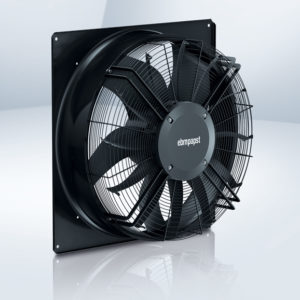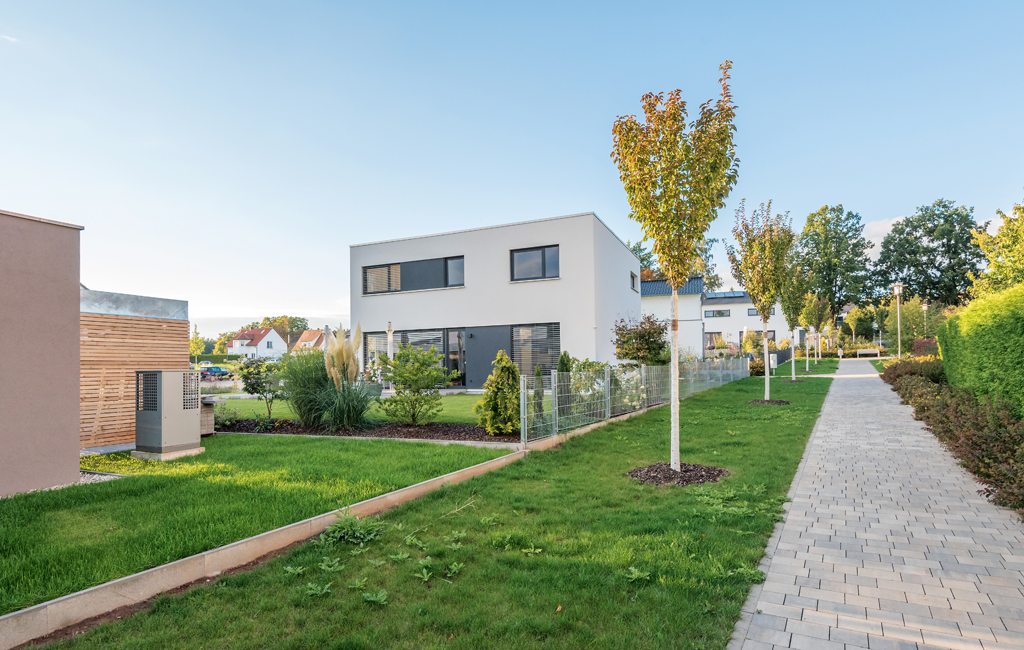In principle, a heat pump works like a refrigerator, which withdraws heat from the food stored in it and transfers it outside. Air/water heat pumps extract heat from the surrounding air and transfer the heat to the heating system, which warms the living areas or is used to heat water. Fans provide the needed air flow through the unit’s evaporator, with the best results always being achieved when the fans are driven by modern EC motors. They are energy-efficient and very quiet, their speed is smoothly adjustable, and they have long service lives.
Axial or centrifugal fan?
There are two types of air/water heat pump; they are designed for indoor or outdoor installation (Fig. 1a, 1b). The two types place different demands on the fans that are used (Fig. 2). In indoor installations, outdoor air is drawn in through one duct and expelled later through another. Centrifugal fans are effective for this application as their design is suited to higher pressure requirements.

Figure 1: Air/water heat pumps for installation indoors (left) and outdoors (right). (Image | BDH/Solarpraxis AG)
They are very compact, benefiting the air/water heat pumps that are also installed indoors where space is usually limited. This also applies for systems that combine the heat pump and the residential ventilation unit (Fig. 3).

Figure 2: Characteristic pressure increase for axial and centrifugal fans. (Graphic | ebm-papst)
In contrast, space is usually not a problem for outdoor installations, where the evaporator is a separate unit and a refrigerant line leads indoors. These configurations mainly use quiet-running axial fans.
With both axial and centrifugal fans in various sizes, motor and fan specialist ebm-papst offers the right fan solution for every air/water heat pump. For example, the proven HyBlade axial fans or the new AxiBlade fans (Fig. 4) are well suited for use in air/water heat pumps in outdoor installations.
The AxiBlades are particularly adaptable to a wide range of applications, where they work with a high efficiency optimum. The new RadiCal centrifugal fans (Fig. 5), which are aerodynamically optimized for energy efficiency and low noise emission, are a good choice for air/water heat pumps in indoor installations and combined systems. They are available in diameters from 190 to 630 mm.

Figure 3: Air/water heat pumps combined with residential ventilation system. (Graphic | ebm-papst)
Energy-efficient and quiet
Modern EC motors are the driving force behind the fans. Users benefit from GreenTech EC technology in several ways. One of them is its energy efficiency. When generating the desired heat output, heat pumps should consume as little primary energy as possible. Though the compressor consumes much more power than the fan, it still pays to have the fan work at the highest possible efficiency. Here there is no alternative to EC technology.

Figure 4: AxiBlade fans work with a high efficiency optimum in a wide range of applications. (Image | ebm-papst)
Noise emission is also important and always needs to be taken into account by those who use air/water heat pumps. The noise level is especially important at night, when the limits imposed by DIN 18005 and “TA Lärm” (German technical guidelines for noise reduction) must be complied with inside and especially outside of buildings. Good interplay among fan impellers or blades with motors and electronics is the key to quiet fan operation. ebm-papst has optimized its blade and impeller geometry to achieve considerable improvements in efficiency and noise emission while also taking psychoacoustic aspects into account (see text box) so that fan noise can be perceived as pleasantly as possible. For quiet operation, the fans can also be combined with guide vanes called FlowGrid that reduce noise resulting from the conditions of installation. Easy control of the EC motors used in the fans also has benefits since the speed can be adapted to actual needs such as speed reduction for nightly temperature reduction.
Smart and communicative

Figure 5: RadiCal fans are quiet, smart and energy-efficient. (Image | ebm-papst)
The electronics integrated in GreenTech EC fans offer further capabilities in addition to motor control. For example, multiple fans can be interconnected via a MODBUS interface. Motor data can be read out and used for purposes like maintenance activities. If the heat pump’s evaporator is deiced when needed rather than cyclically, the current speed of the fan can be used for monitoring; a decrease in speed can be a sign of ice formation. Error messages from internal sensors can also be read out, enabling remote monitoring of the fans in keeping with the GreenIntelligence philosophy.
The EC fans are also ideally equipped for the future as the use of natural refrigerants is not a problem for them. Their energy efficiency and low noise emissions make them a future-proof solution for the heat pump sector.
Psychoacoustics – how is a fan supposed to sound?
Psychoacoustics is concerned with describing personal sound perception in relation to measurable noise levels, i.e. it aims to explain why we perceive noises as pleasant or unpleasant. This is something that physical measurements of sound levels in test rigs are unable to address. For example, trumpet music and a construction-site excavator have approximately the same sound power but are perceived psychoacoustically in completely different ways.
ebm-papst addressed this matter by setting up a special psychoacoustic laboratory in which noise from fans in various configurations is played back for eight test subjects. Employees question the subjects afterwards to build up a scientifically founded database based on the following psychoacoustic parameters: loudness (unit: sone), sharpness (unit: acum), pitch (unit: mel), roughness (unit: asper) and fluctuation strength (unit: vacil).
Other important quantities are tonality and impulsiveness. They can be measured with microphones and compared with comments made by the test subjects. Assessments by the test subjects are analyzed with statistical and psychological methods. The results are used for product development. The ultimate aim is to develop a fan whose operating noise is perceived as pleasant by as many test subjects as possible.

Additionally, the discussion on fan selection criteria and energy efficiency considerations underscores the importance of informed decision-making in HVAC system design and maintenance. Overall, this article serves as a valuable resource for both professionals and homeowners looking to enhance the efficiency and effectiveness of their heat pump systems.